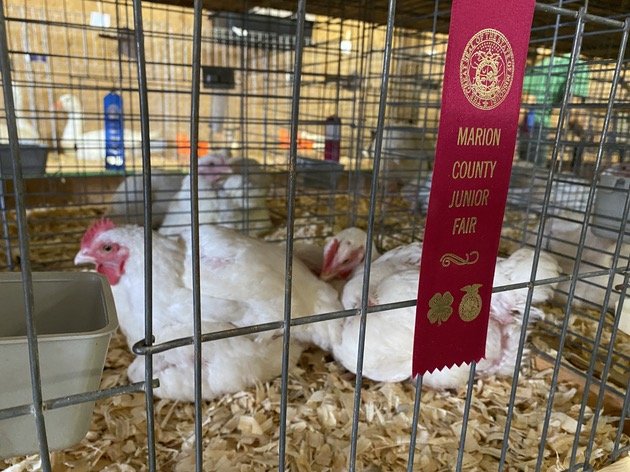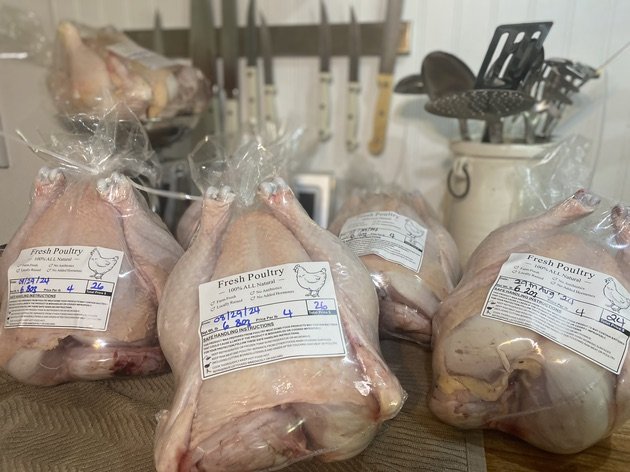Cornish Cross Chickens: Pros, Cons & Raising Tips
This was a first for us, not raising meat birds for the table, but raising cornish cross - the broiler breed. It all came about as the kids were signed up for poultry projects in 4H and the project leader arranged a very discounted purchase price for chicks, so we got 50!
Anyone who has ever raised this breed knows, there is nothing normal about these chickens! The speed at which they grow is scary. At 6 weeks old our show birds, (pictured) are the same size and weight as our 1 year old laying hens!
Are they genetically modified?
Contrary to popular opinion the cornish cross chickens are actually not GMO organisms. They are the result of cross breeding the cornish and white rock chicken breeds which have then been selectively bread over many generations to produce a chicken that matures so fast it is fully grown by 6-8 weeks of age. Perhaps one could argue that the genetics have been modified or manipulated through breeding, but it wasn’t done in a lab!
Our free range cornish cross.
While the selective breeding of this hybrid breed has led to a bird that converts food into meat more efficiently than any other breed out there, raising this breed in all honesty didn’t really impress us.
The downside of cornish cross
As I already mentioned this breed grows too fast for its own body. This results in obese chickens that become easily injured simply by moving around. If you actually stand and watch them for any length of time you will notice they almost prefer not to move, perhaps they are aware that they are too overweight to do so!
Subject to nothing but its own appetite, the cornish cross chicken basically wants to sit next to a feed bowl 24/7 and will eat as much food as you care to provide only hauling themselves from feed bowl to feed bowl to choke as much grain down their necks as chickenly possible! In my quest to try and find a better balance for our birds, i tried feeding different rations to see if it would encourage free ranging behaviour, however, my efforts failed and I was met with with hangry birds once or twice who would only start pecking on each other unless allowed to devour a $30 bag of meat bird food in a day!
Aside from injury rate and food dependence making the breed unsustainable ( in my opinion) the other issue we ran into was the weather. We started raising our spring chicks in July which is when cornish cross are typically available, however by the time we were approaching ‘the day’ the outdoor temps were soaring into the 90’s and we sadly lost a few birds simply because they got too hot. In spite of giving electrolytes ( which helps our egg layers cope with the heat just fine) our vet commented that its not unusual for the breed to over heat, putting undue pressure on their under sized hearts which just can’t keep up.
Caleb and his dad - who taught him 'how'.
Harvesting pressure
Just like any cash crop, with broilers there are expected parameters to work to. The cornish cross are bread with the intention of you having them in the freezer by the time they are 8 weeks old or else! Some people may prefer the ‘get it done and get it over with ‘ approach however the truth is, it takes a good few hours to get a few birds done even when the whole family are pitching in. Fitting this sort of commitment into family life is probably something you should consider up front if you’re thinking about raising this breed. With all kinds of commitments on our calendar, dates got moved and pushed around and our last birds were harvested at 10 weeks old weighing in at 8-9lbs dressed weight!
Finding the ‘right time’ when every extra day raises the cost of food and production beyond what you might reasonably want to invest in a home raised chicken, can add an undue pressure to the task of raising them and in hi-insight by comparison to other meat breeds we have raised doesn’t necessarily produce a superior product.
The final product
There is no doubt that a home raised, home harvested chicken is the reward we keep in mind all the while caring for the birds we know wont be around for long. Before I was farming I would buy a rotisserie chicken from the grocery store without a second thought for the animal or the life it had and that’s not even getting into the conversation about how grocery store chicken is processed. I can’t say that I do that now…
Ready for the freezer
If you haven’t eaten home raised chicken before I encourage you to purchase one from a local farmer, homesteader or at your nearest farmers market. The texture of home raised chicken is much more meaty & dense than what you would be used to from the grocery store, but remember, this is chicken that has not been injected with saline solution or water. Most of our chickens we freeze as whole birds for our own rotisserie meat but some we will de-bone into breasts and legs for using in other recipes.
Home raised fried chicken in lard.
Raising your own meat is sobering, no one likes death and there is nothing pretty about the process. I did consider at one point if I could even bring myself to enjoy eating an animal we had raised on our farm……but in all honesty - enjoying home raised chicken fried in lard - it wasn’t hard at all!





